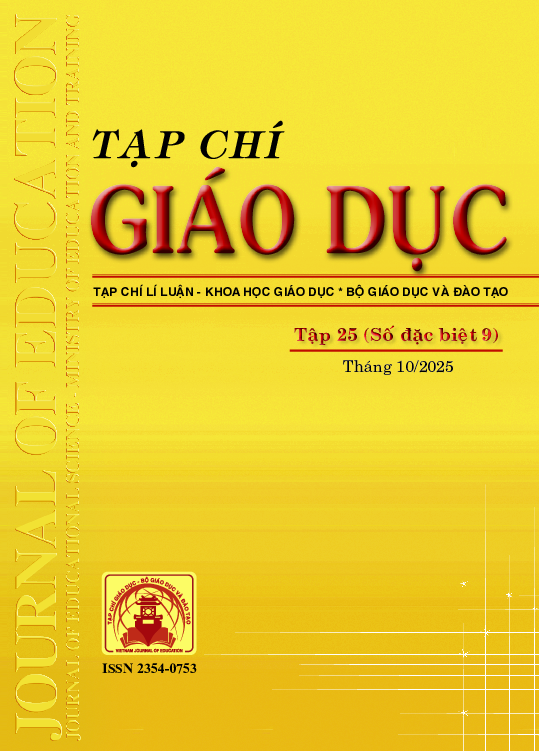Vận dụng kĩ thuật mảnh ghép trong dạy học chủ đề “Năng lượng và cuộc sống” (Khoa học tự nhiên 6) nhằm phát triển năng lực giải quyết vấn đề và sáng tạo cho học sinh
Tóm tắt
In the context of education aiming at developing students' competence, choosing active teaching methods to improve problem-solving and creativity is an important requirement. The article focuses on studying the application of Jigsaw method in organizing learning activities for 6th grade students with the topic “Energy and Life” (Natural Science 6). Based on theoretical research, the authors develop a lesson plan oriented to competence, in which students are organized to study in groups, performing differentiated and integrated tasks. The research results contribute to clarifying the relationship between the Jigsaw method and the development of problem-solving and creativity, and at the same time suggest ways to design effective lessons that can be implemented in general education practice. The article also recommends continuing in-depth and experimental research to verify the effectiveness of this design.
Tài liệu tham khảo
Aronson, E., Blaney, N., Stephan, C., Sikes, J., & Snapp, M. (1978). The Jigsaw Classroom. Beverly Hills, CA: Sage Publications.
Bộ GD-ĐT (2018). Chương trình giáo dục phổ thông môn Khoa học tự nhiên (ban hành kèm theo Thông tư số 32/2018/TT-BGDĐT ngày 26/12/2018 của Bộ trưởng Bộ GD-ĐT).
Bùi Hiền, Nguyễn Văn Giao, Nguyễn Hữu Quỳnh, Vũ Văn Tảo (2001). Từ điển Giáo dục học. NXB Từ điển Bách khoa.
Denyse, T. (2002). The Competency - Based approach: Helping learners become autonomous. In Adult Education - A lifelong Journey.
Dewey, J. (1938). Experience and education. Southern Illinois University Press.
Hoàng Phê (1992). Từ điển tiếng Việt. Trung tâm Từ điển ngôn ngữ.
Mai Hoàng Phương, Lê Đức Anh Tuấn (2024). Chủ đề STEM với nội dung “Chuyên đề 10.3. Vật lí với giáo dục về bảo vệ môi trường” dựa trên quy trình 6E nhằm phát triển năng lực giải quyết vấn đề và sáng tạo của học sinh lớp 10. TNU Journal of Science and Technology, 229(01/S), 265-272. https://doi.org/10.34238/tnu-jst.9212
Nguyễn Lăng Bình, Đỗ Hương Trà (2021). Dạy và học tích cực. Một số kĩ thuật và phương pháp dạy học. NXB Đại học Sư Phạm.
Nikolova, G., Vankova, D., & Vankov, P. (2025). Promoting the Jigsaw method in teaching. In INTED2025 Proceedings (pp. 299-303). IATED.
Phạm Minh Hạc (1988). Tâm lí học (tập 1). NXB Giáo dục.
Roseth, C. J., Lee, Y. K., & Saltarelli, W. A. (2019). Reconsidering jigsaw social psychology: Longitudinal effects on social interdependence, sociocognitive conflict regulation, motivation, and achievement. Journal of Educational Psychology, 111(1), 149-169.
Slavin, R. E. (2014). Educational Psychology: Theory and Practice. Boston: Pearson.
Thủ tướng Chính phủ (2015). Quyết định số 2068/QĐ-TTg ngày 25/11/2015 phê duyệt Chiến lược phát triển năng lượng tái tạo của Việt Nam đến năm 2030, tầm nhìn đến năm 2050.
UNESCO (2022). Education for Sustainable Development Goals: Learning Objectives. Paris: UNESCO.
Vũ Văn Hùng (chủ biên), Đinh Đoàn Long, Lê Kim Long, Bùi Gia Thịnh (đồng chủ biên), Nguyễn Hữu Chung, Nguyễn Thu Hà, Bùi Thị Việt Hà, Nguyễn Đức Hiệp, Trần Thị Thanh Huyền, Lê Trọng Huyền, Vũ Trọng Rỹ, Nguyễn Văn Vịnh (2021). Khoa học tự nhiên 6 (Bộ Kết nối tri thức với cuộc sống). NXB Giáo dục Việt Nam.
Weiner, F. E. (2001). Comparative performance measurement in schools. https://www.sciepub.com/reference/243635
Đã Xuất bản
Cách trích dẫn
Số
Chuyên mục
Giấy phép

Tác phẩm này được cấp phép theo Ghi nhận tác giả của Creative Commons Giấy phép quốc tế 4.0 .












